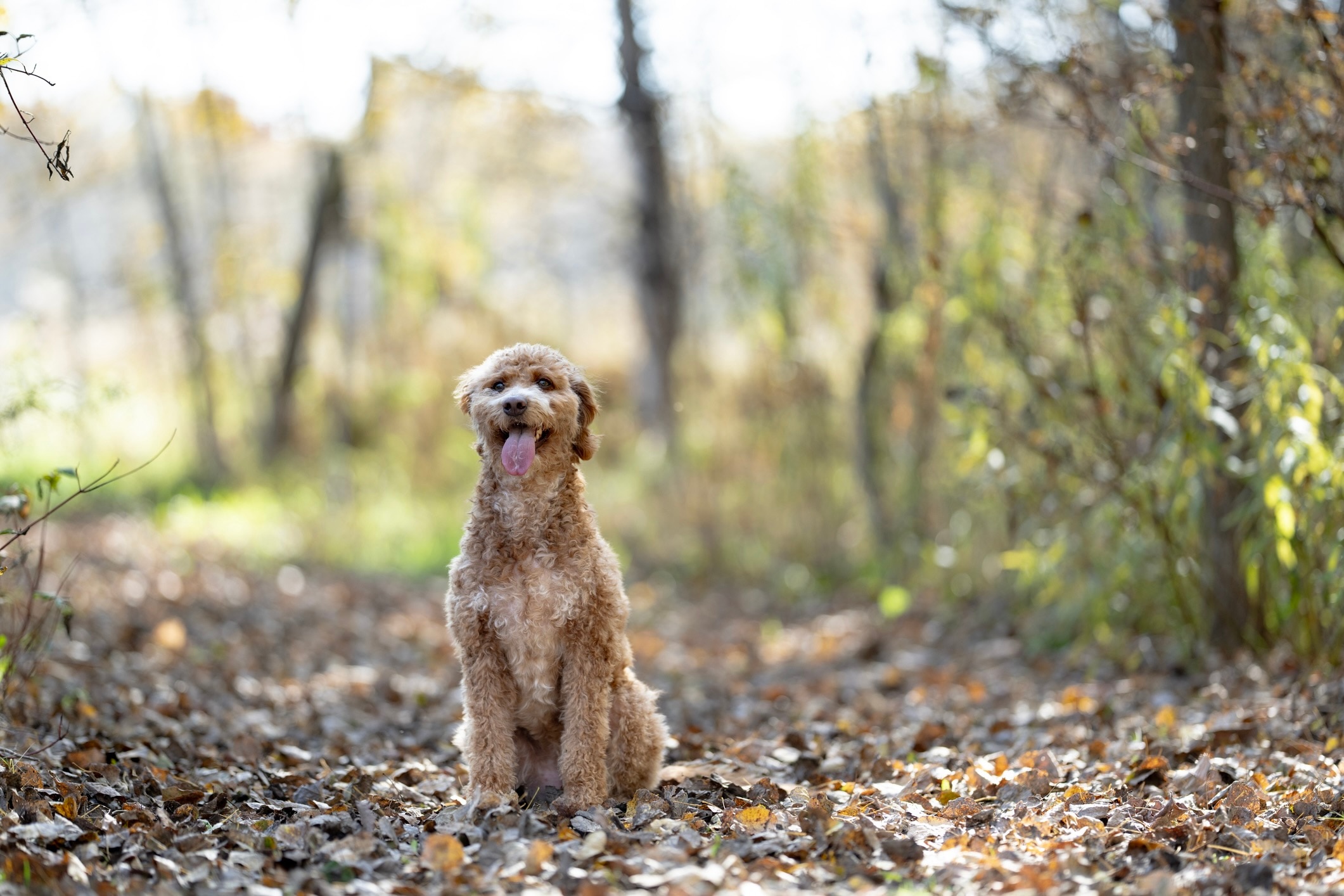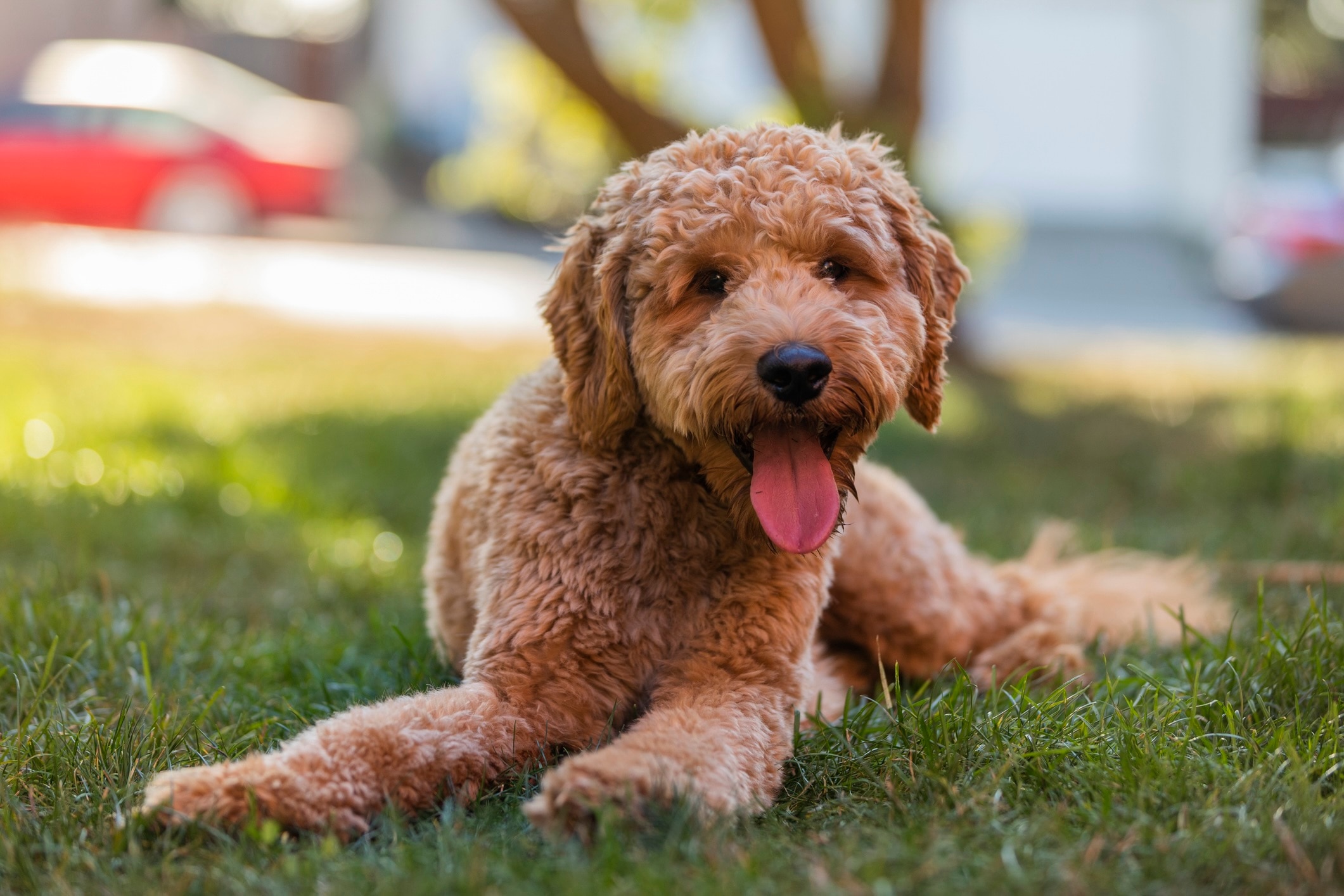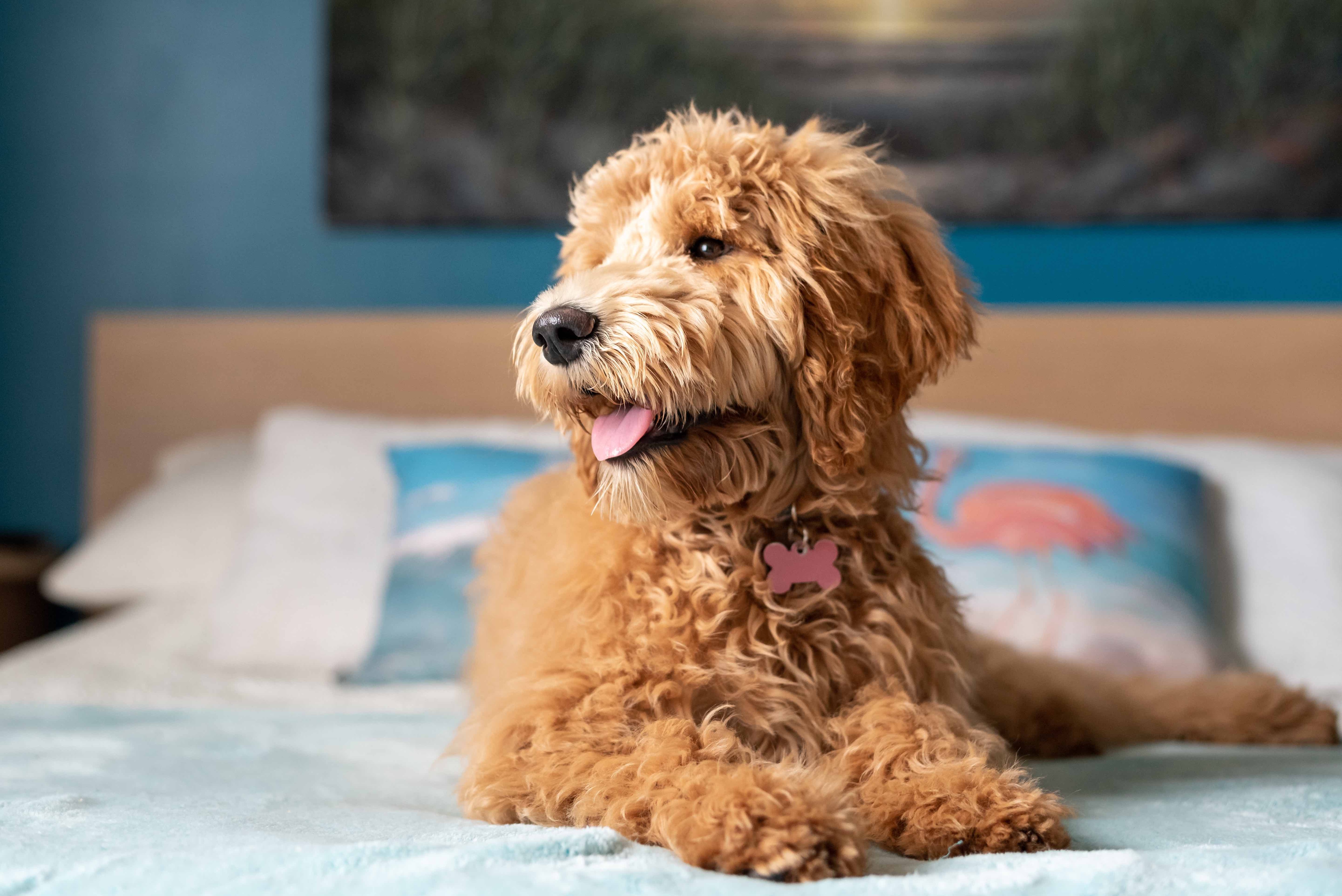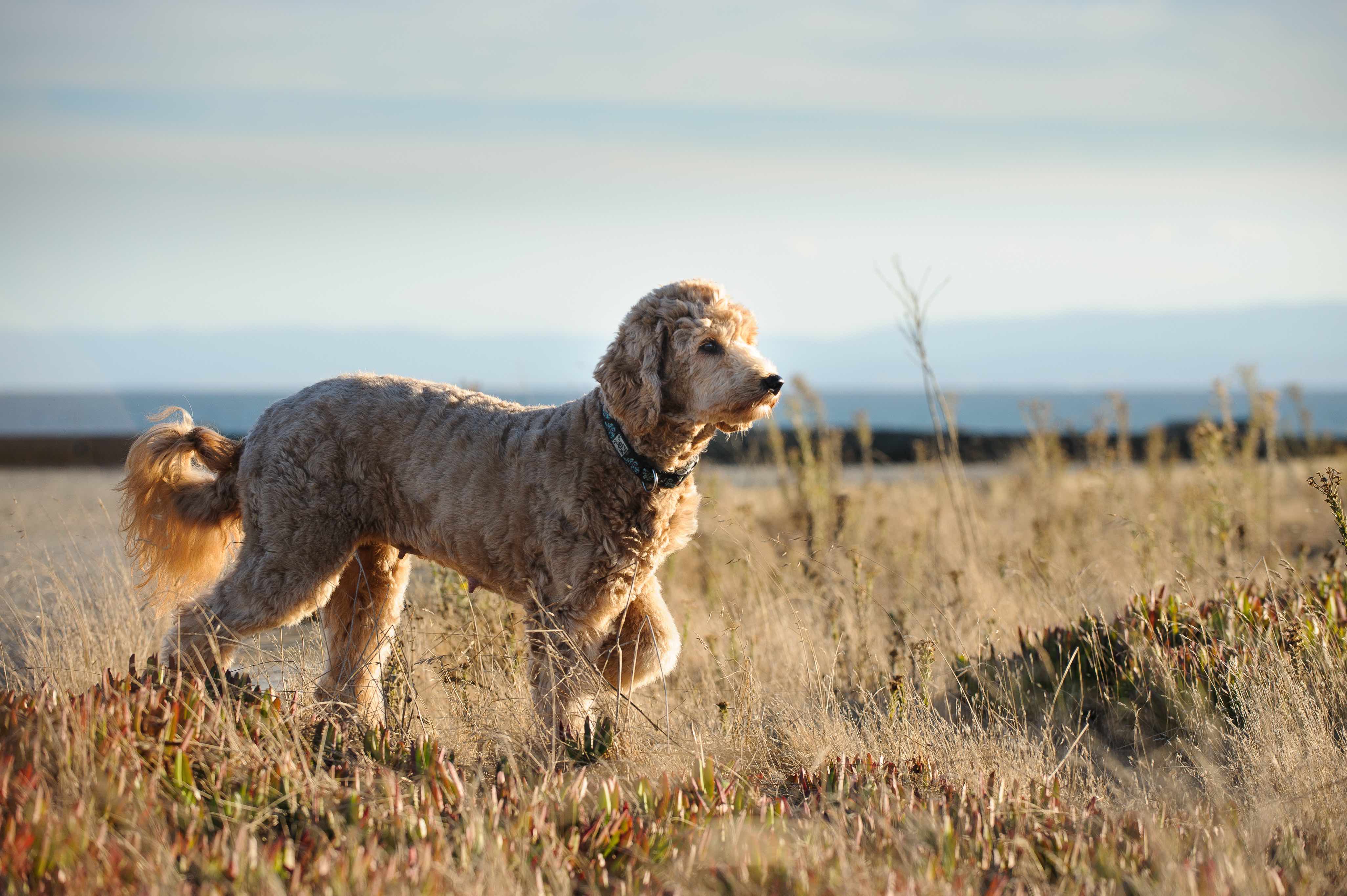Goldendoodle
iStock/LSOphoto
First bred in the late 1960s as a guide dog, the Goldendoodle—a crossbreed of a Golden Retriever and a Poodle—became a popular household pet in the United States during the 1990s. Since then, the dogs have been coveted companions that are beloved for having low-shedding qualities, a clever and highly trainable personality, and a patient family-friendly nature.
The standard-sized, wavy-haired Goldendoodle can grow to 20–24 inches tall and about 50–90 pounds, but they also come in smaller sizes as Mini Goldendoodles. It all depends on which Poodle parent they have: the Standard Poodle or the Miniature Poodle.
Caring for a Goldendoodle

The Goldendoodle is bred to exhibit the best qualities of both the Golden Retriever and the Poodle. The result is a smart and fun-loving dog that’s a wonderful addition to any household—if given the proper amount of exercise to satisfy their high energy level.
Goldendoodles are very intelligent (both of their pet parents are considered to be some of the smartest dog breeds) and do well in obedience classes and agility training.
While they can live happily with other dogs, cats, and children, the pups can also be prone to separation anxiety. That’s why pet parents must make sure their Goldendoodle gets plenty of social activity every day and avoid leaving them alone at home for long periods of time (more than eight hours).
Goldendoodle Health Issues

As generally healthy dogs, the average Goldendoodle lifespan is 10–15 years. But they are prone to common health conditions found in both Poodles and Golden Retrievers.
While you can’t ensure your dog will be free of health problems, you can purchase your Goldendoodle puppy from a reputable breeder, says Jamie Whittenburg, DVM, veterinarian at Kingsgate Animal Hospital in Lubbock, Texas.
“Breeders should be thoroughly testing their breeding stock by performing OFA or PennHip testing on their hips, echocardiograms with a cardiologist, and extensive genetic testing prior to breeding,” Whittenburg says.
Hip Dysplasia
Hip dysplasia is a common issue for large- and giant-breed dogs and happens when the hip joint develops abnormally, resulting in a loose joint. It can happen during a Goldendoodle puppy’s growing phase.
Discomfort is commonly displayed by pups via limited mobility, which can include reduced activity, difficulty going up stairs, or even difficulty just getting up. There are many options for treating hip dysplasia, from joint supplements to anti-inflammatory medications to surgery, but it’s vital to consult your vet to find the best treatment for your Goldendoodle.
When left untreated, hip dysplasia can lead to arthritis in dogs.
Heart Disease
Goldendoodles are genetically predisposed to heart disease, particularly a congenital variation called subvalvular aortic stenosis (SAS).
This is when the heart’s aortic valve narrows, creating an obstruction. The heart must work harder than normal to pump blood through this narrowed area, causing heart muscle abnormalities, says Whittenburg.
Though there are no foods or things to avoid that will prevent an inherited heart defect, you can (and should!) ask your Goldendoodle breeder if their puppies’ parents have been screened for heart disease.
Symptoms include difficulty breathing and a sudden loss of consciousness (syncope).
Eye Issues
Goldendoodles are susceptible to three eye conditions: glaucoma, cataracts, and progressive retinal atrophy (PRA).
Glaucoma is an eye disease involving increased pressure. Symptoms pet parents should look out for include bulging eyeballs, watery discharge, redness to the whites of the eyes, and dilated pupils. The condition can be treated with long-term medication. If left untreated, glaucoma can lead to blindness in dogs.
Cataracts is a common condition in dogs that causes clouding in the eyes and can lead to vision loss. If you notice that one or both of your Goldendoodle’s eye lenses has a cloudy or opaque appearance, or that their vision has become more limited, consult a veterinary professional. Cataracts can be treated with surgery.
PRA is when the eye’s retina breaks down and leads to blindness. There is no cure, and early symptoms include night blindness or reluctance to go outside in the dark, increased clumsiness, and cataracts.
Gastric Dilatation-Volvulus (GDV)
Gastric dilatation-volvulus is a severe case of bloat in dogs, when a dog’s stomach inflates with food and gas and then twists. This twisting cuts off blood flow to and from the stomach and spleen, and it’s a life-threatening medical emergency.
Dogs with deep chests, such as Standard Poodles, can develop bloat and GDV. This means large Goldendoodles might be at risk.
Take your dog to the emergency veterinarian immediately if you notice any signs of GDV in your Goldendoodle, including:
-
Retching without vomiting
-
Pacing
-
Distended abdomen
What To Feed a Goldendoodle

Feed your Goldendoodle a dog food that meets the nutritional standards set by the Association of American Feed Control Officials–compliant dog foods, such as Purina Pro Plan, Hill’s Science Diet, and Royal Canin.
Talk to your vet about the best dog food for your Goldendoodle. Along with AAFCO compliance, your Goldendoodle needs to eat a food formulated for their life stage: puppy, adult, or senior.
How To Feed a Goldendoodle
It’s important to keep your dog at a healthy weight, as obesity in dogs can cause health conditions and make existing conditions worse. Feed your Goldendoodle two measured meals twice a day. Goldendoodle puppies may benefit from more frequent meals, up to four a day.
Take steps to reduce the chance of life-threatening GDV when feeding your dog:
-
Do not allow your dog to exercise for one to two hours before or after eating.
-
Avoid using elevated food bowls.
-
Feed your dog with a slow feeder bowl, snuffle mat, or puzzle toy. This slows down their eating, which can help prevent bloat.
-
Feed your dog multiple smaller meals throughout the day. Feeding one big meal puts your pup at risk of bloat.
How Much Should You Feed a Goldendoodle?
To determine the appropriate amount of food to give your Goldendoodle, chat with your veterinarian. They will assess your pup’s lifestyle, health, reproductive status, allergies, and breed to determine how many kilocalories your dog should consume daily.
“Take the food, or a picture of the nutrition label, to the vet with you and they will calculate the amount of that food that you should be feeding,” Whittenburg says. “If you are preparing a homemade diet, the veterinary nutritionist will calculate this for you.”
Generally, Goldendoodle puppies under 6 months old should be fed a minimum of three times a day and adult dogs should be fed twice a day.
Nutritional Tips for Goldendoodles
Unless recommended by a veterinarian, dogs fed a complete and balanced commercial food diet should not need any nutritional supplements. This means it’s important to pick a food catered to your Goldendoodle’s life stage, whether they’re a puppy, adult, or senior.
Dog treats should make up only 10% of your Goldendoodle’s calorie intake and never replace a diet.
Behavior and Training Tips for Goldendoodles
Goldendoodle Personality and Temperament

The Goldendoodle personality makes them good family dogs and can live well in homes with other dogs.
“They are also generally good around cats and children, although there may be some initial adjustment period as they get used to new family members,” says Sophie Whoriskey, DVM, associate director at Hawai’i Conservation Medicine.
Both Standard and Miniature Goldendoodles are energetic dogs that require 30–60 minutes of physical exercise per day. This can encompass a combination of everything from neighborhood walks and runs to hikes and playtime.
Goldendoodle Behavior
Because Goldendoodles cherish time spent with their family, they are prone to separation anxiety if they don’t receive the proper amount of social and mental stimulation. Pet parents should avoid leaving their four-legged friends at home alone for too long. Crate training and hiring a pet sitter or dog walker can help with separation anxiety.
Goldendoodles are energetic dogs that require 30–60 minutes of physical exercise per day.
While these laid-back canines aren’t big barkers, they can become vocal to alert their humans. But overall, Goldendoodles are known for their gentle temperament, making them ideal for households with kids and seniors.
“They especially benefit from having a strong bond with their human family and being part of the daily routine,” Whoriskey says.
Goldendoodle Training
Although the typical Goldendoodle’s temperament makes them a friendly dog, socializing your puppy is important to help them grow into their best, most confident self. Socializing a Goldendoodle puppy involves exposing your dog to new stimuli so they become comfortable in new situations.
Goldendoodles are known for being smart and easily trained, so they excel in activities like agility and obedience classes. They respond well to positive reinforcement techniques, using treats to reward good behavior.
It’s also important to train Goldendoodle puppies at a very young age to ensure they develop good habits that will last throughout their lifetime and minimize mischievous behavior. “With patience and consistency, you will be able to teach your Goldendoodle many tricks and commands,” Whoriskey says.
Fun Activities for Goldendoodles
-
Walking
-
Obedience
-
Running
-
Hiking
Goldendoodle Grooming Guide

Because they’re a mix of Golden Retriever and Poodle, Goldendoodles are known for their beautiful curly (or wavy!) coat that sheds minimally. But Goldendoodle pups require a high-maintenance hair care routine, including regular brushing and appointments with a professional groomer.
Skin Care
While Goldendoodles don’t require a regular bathing routine, your dog may benefit from a splash in the shower or tub if they get wet or dirty from adventures outside. Always use a dog-safe shampoo and ask your vet how often you need to bathe your dog.
Coat Care
To avoid unruly tangles and matting, Goldendoodles need constant and regular grooming. Brush your dog at least a few times a week.
“Training these dogs from a young age to allow for this consistent grooming is absolutely critical,” says Mindy Waite, CAAB, CPDT-KA, clinical assistant professor in animal behavior at Carroll University in Waukesha, Wisconsin. “In addition, [pet parents] must be prepared to spend a good deal of money on grooming every four to eight weeks.”
Eye Care
Trim your pup’s bangs to ensure their hair doesn’t block their vision. Because Goldendoodles are prone to eye conditions such as glaucoma and cataracts, pet parents should also keep an eye on respective symptoms and contact their veterinarian if needed.
Ear Care
To prevent infections in your Goldendoodle’s ears, always keep them clean and dry, especially after a bath or a swim. Ask your vet if you need to routinely clean your dog’s ears and, if so, which ear-cleaning products to use.
Dental Care
Brush your dog’s teeth every day. All dogs, especially smaller breeds like Mini Goldendoodles, are at risk of dental disease. Brushing with dog-safe dental tools is the best way to combat this condition.
Considerations for Pet Parents

The Goldendoodle is a friendly, bouncy, high-energy breed that comes in different sizes, making them an ideal companion for any household. While they prefer a yard with room to run around, the adaptable Goldendoodle temperament makes them a fit for city apartments, too.
When bringing home a Goldendoodle puppy, be prepared to provide your pup with proper positive reinforcement training and attention. Goldendoodles require ample amounts of training and exercise every day, particularly in their early puppy years, to stay entertained, tired, and happy, Waite says.
Goldendoodle FAQs
Do Goldendoodles shed a lot?
No, Goldendoodles have a reputation for being “hypoallergenic” dogs because they don’t shed much. However, no dog is 100% allergen-free.
Pups that are 75% Standard Poodle and 25% Golden Retriever (aka an F1B Goldendoodle) are born with curlier Poodle coats that can be better for allergy-sensitive pet parents. That said, the amount of sensitivity to a dog’s allergens varies from person to person, so spend time with the breed before bringing home a Goldendoodle puppy.
How long do Goldendoodles live?
On average, the lifespan of a Goldendoodle is 10–15 years. Because small dog breeds tend to live longer than bigger dogs, Miniature Goldendoodles typically live longer than big Goldendoodles.
Are Goldendoodles smart?
Yes, Goldendoodles are very smart dogs. In fact, both of their parent breeds are commonly cited as two of the smartest dog breeds.
Are Goldendoodles expensive?
Yes. The average price of a Goldendoodle puppy can range from $1,500–$5,000, depending on the breeder, size, lineage, location, and other factors. While a puppy is a worthy investment, potential pet parents should also consider the costs of caring for a Goldendoodle, which includes vet visits, grooming, training, and food.
What’s the difference between Goldendoodles vs. Labradoodles?
While Goldendoodles and Labradoodles are both popular doodle dogs with gentle natures, playful personalities, and low-shedding coats, they have distinctive differences.
The Goldendoodle is the result of a Golden Retriever bred with a Poodle, while the Labradoodle is the result of a Labrador Retriever bred with a Poodle. Goldendoodles tend to have a longer lifespan and a calmer energy level than Labradoodles, though both breeds require regular exercise.
